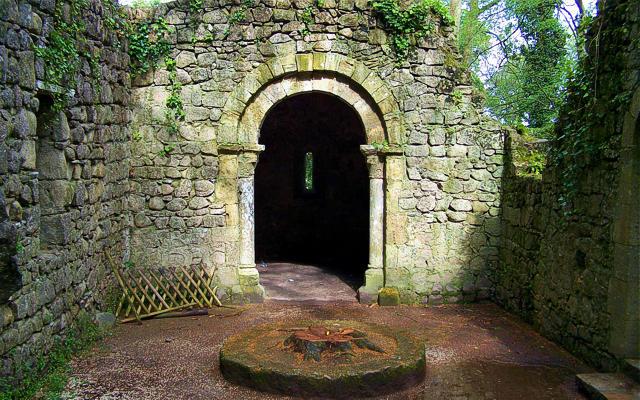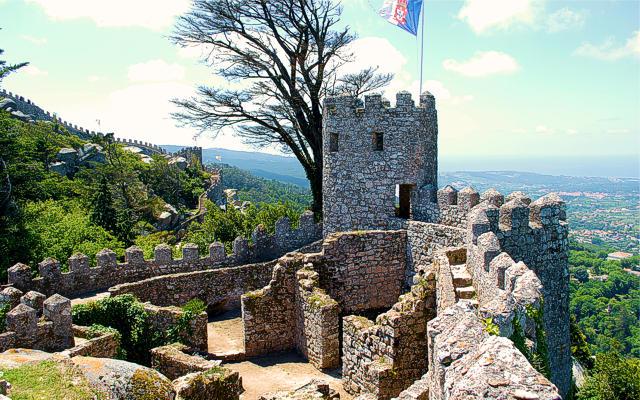Castle of the Moors
Dates back to the early days of the Moorish occupation (8th century)
History
Winding over two ridges of the Serra de (Mountain of) Sintra, the Castle dates back to the early days of the Moorish occupation of the Peninsula, the 8th century.
Around 1100, while Portugal was still under Moorish domination, the castle changed hand several time as the Christian Kings during the Crusades , nor the Arabs Emirs could keep the position a long time.
In 1108, the Norwegian King Sigurd the Crusader conquered the Castle while on his way to Jerusalem.
It is only in 1147, after various attempts that the Castle was definitely taken by the first King of Portugal, Afonso I (1109-1185).
Later on the castle lost its strategic importance as, peace being restored, there was no more need to protect the population inside its walls and was therefore abandoned.
It was acquired, as well as the Pena Palace, in 1838 by Ferdinand Saxe Coburg-Gotha (1816-1885), King Consort of Queen Maria II .
He restored the medieval ruin and afforested the surrounding areas, giving it a new dignity.
The latest restoration happened in 1940 for the ceremonies celebrating the foundation of Portugal.
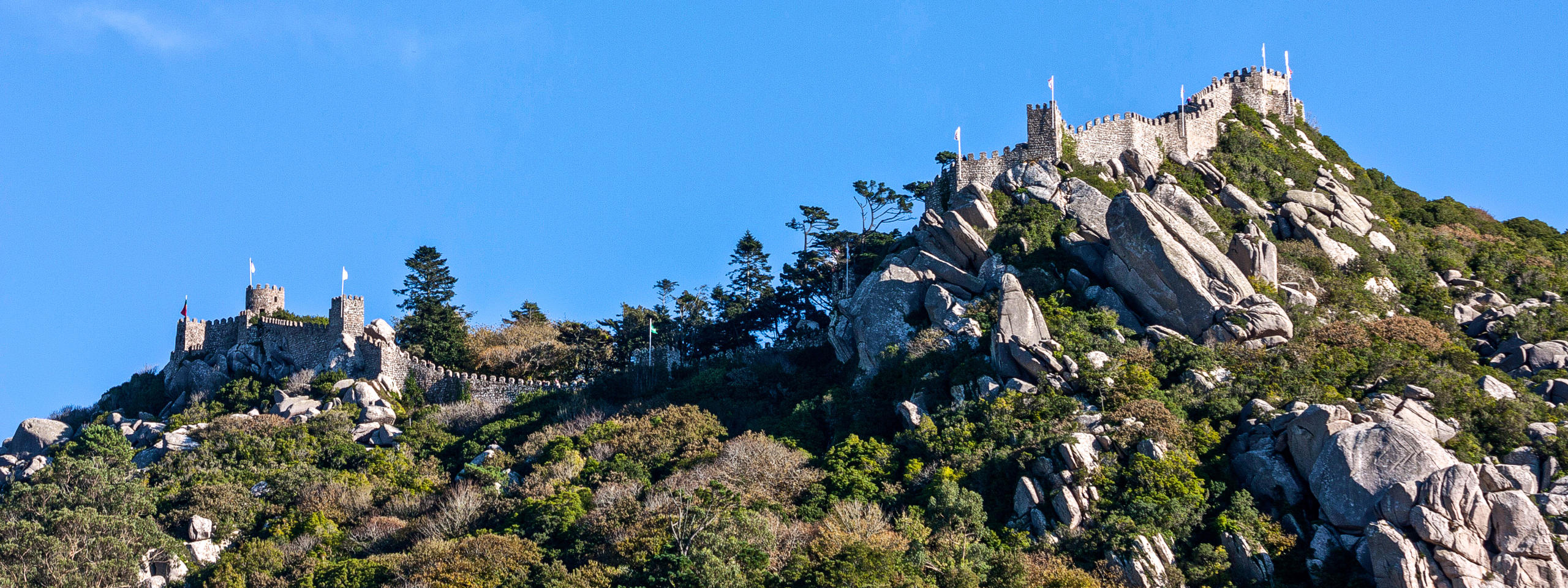
Features
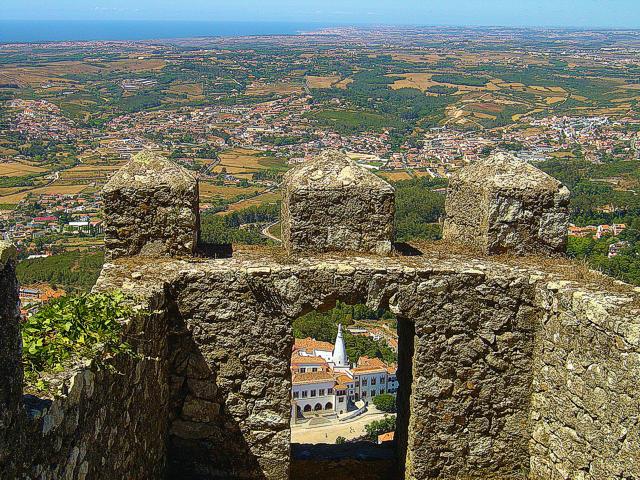
View from the Castle featuring Sintra's Palace in the arch
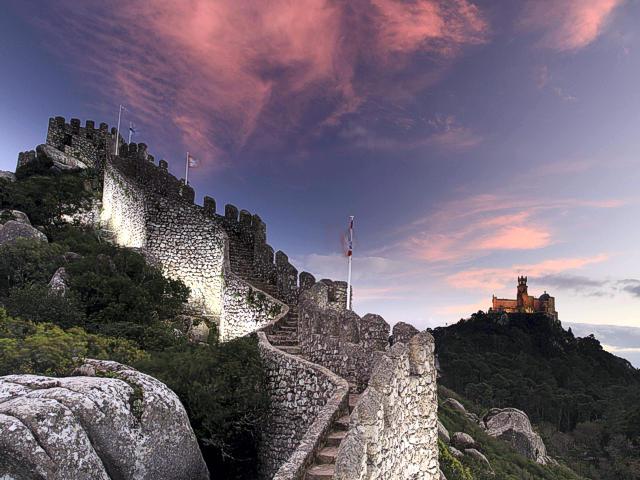
Walls of the Castle with the Pena Palace in the background on the right
From the top of the walls, it is possible to admire Sintra and its Palace, the Pena Palace, the ocean's coastline, the Praia (Beach) das Maçâs, the town of Ericeira & Mafra and the hills of Sintra, covered in green and dotted with beautiful homesteads and romantic chalets.
The castle has an irregular plan and is composed of a double belt of walls.
The internal wall features battlements and reinforcement provided by five fortified towers.
Inside, a cistern, fed by a source which later on was canalised to the city's Palace.
After reconquering Lisbon in 1147, Afonso I built inside the walls the Romanesque Chapel of São Pedro, of which interesting traces remain, next to the oppidum, where there is also an Arab horseshoe arch gate and remains of houses.
This chapel retains two interesting Romanesque doorways and in the chancel are traces of fresco paintings, as well as several tombs from the former medieval necropolis.
Archaeological excavations, that may be observed by visitors, are currently underway and these have already cleared up many of the questions about the history of human presence in this area.
Opening Hours
Open all year except December 25th and January 1st
Last entry 1 hour before closing time
Summer 2018 up to
From 09:30 until 20:00, last entry 19:30
Winter 2017-2018 up to
From 10:00 until 18:00, last entry 17:00
€ Prices up to Oct 27, 2018
| Children up to 5 years Entry | € Free |
| Children from 6 up to 17 years Entry | € 6,50 |
| Adult Entry | € 8,00 |
| Senior (above 65 years) Entry | € 6,50 |
| Family (2 adults + 2 children) Entry | € 26,00 |
Coordinates: 38.7960136; -9.3892979
Bus 434 (Pena line)
9 minutes from and 20 minutes to Sintra Train Station
Frequency:
Every 15 minutes, from 09:30 until 18:20
Detailed timetable

Itinerary:
Sintra Train Station > Historic City Centre - Tourist Office - Sintra National Palace > Castle of the Moors > Pena Palace > Historic City Centre - Sintra National Palace > Sintra Train Station
Route Calculator | Scotturb, Cascais Sintra Busses Website
Public transportation in Sintra
Accommodation nearby
out of which:
Moon Hill Hostelsee on Google Maps | |
Sintra Boutique Hotel 4see on Google Maps | |
Penha Longa Resort 5see on Google Maps | |
Quinta Velha Guesthousesee on Google Maps |
Related Links
Pena Palace - Wikipedia
King Fernando II of Saxe Coburg-Gotha - Wikipedia
Elise Friedericke Hensler, Countess d'Edla - Wikipedia

Walls of the Castle with the Pena Palace in the background on the left
